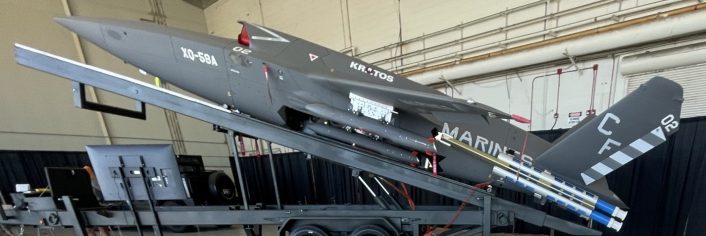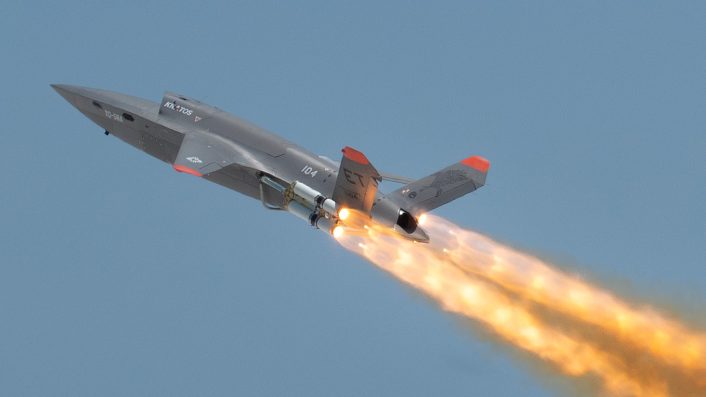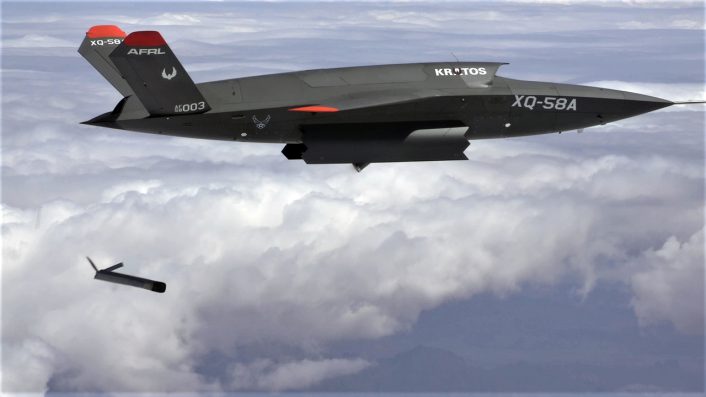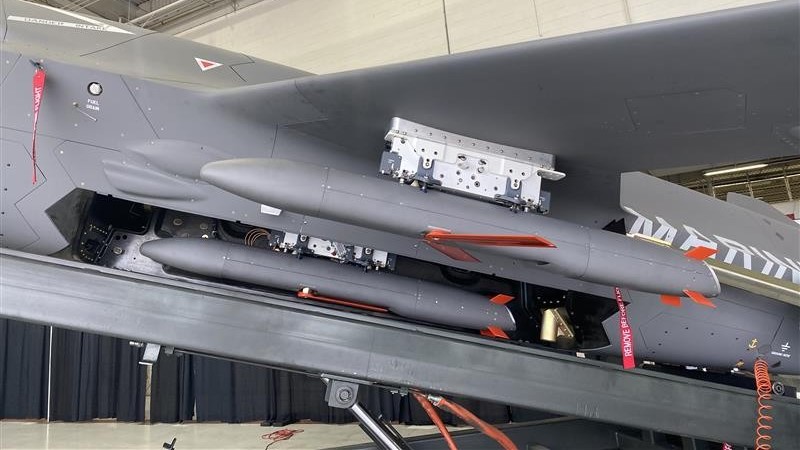Ragnarök promises 500-nm range, high-altitude performance, and flexible carriage to deliver maximum capability at minimum cost for the XQ-58 Valkyrie.
Kratos Defense & Security Solutions has unveiled its new Ragnarök Low-Cost Cruise Missile (LCCM), which will give the XQ-58A Valkyrie – also built by Kratos – tactical strike capabilities. The weapon is a compact, wing-folding strike system designed to deliver long-range precision effects from both manned and unmanned aircraft, but at a fraction of traditional cruise missile costs.
Revealed publicly during the recent MCAS Miramar Air Show, Ragnarök was displayed on a XQ-58A collaborative combat aircraft (CCA) carried both on an external hardpoint and in the internal weapon bay. The company describes the system as a “high-performance strike system” engineered for affordability, rapid production, and compatibility with multiple launch platforms.
According to Kratos’ announcement, the Ragnarök LCCM combines a range of 500 nautical miles (926 km), payload of 80 pounds (36 kg), cruise speeds greater than Mach 0.7, and operational ceilings up to 35,000 feet. These performance figures place Ragnarök well above typical loitering munitions while remaining within the “attritable” cost range, with Kratos describing it as ideal for precision engagement missions across a variety of operational scenarios.
A compact, modular strike system
Ragnarök’s compact airframe is built around carbon-composite fuselage and empennage structures, combined with an innovative underwing folding mechanism that enables easy storage, transport, and carriage, says the company. The weapon is compatible with standard 14-inch rack systems, allowing installation in internal weapons bays, underwing pylons, or even on palletized launch systems for transport aircraft.

Kratos further said the weapon’s primary design objective is to create an affordable, high-volume strike option that can be carried by platforms like the Valkyrie and other future collaborative combat aircraft.
“The Ragnarök LCCM represents our commitment to developing high-performance strike systems that meet the evolving needs of today’s warfighter in conjunction with the budget realities that dictate what systems ultimately make it to the field.”
Steve Fendley, President of Kratos’ Unmanned Systems Division.
With an estimated unit cost of $150,000 in production lots of 100, the Ragnarök could be priced roughly an order of magnitude lower than many current-generation tactical cruise missiles. In turn, this would potentially enable saturation attacks or distributed strike operations at sustainable cost levels.
This also reflects the current trends of the military trying to lower the price of the long-range weapons, which currently have an average unit cost of over $1 million. An example is the U.S. Air Force’s Enterprise Test Vehicle project, which serves as foundation for a cheap mass production with a cost goal of $150,000 per unit.
The Ragnarök project, however, appears unrelated, as Kratos was not among the companies selected for the ETV project. Additionally, the company says it has self-funded the program to ensure speed and production readiness.
“Kratos Ragnarök LCCM is a recent example of Kratos making the internally funded investment, moving fast, and rapidly developing a relevant, ready-for-high-quantity-production weapon system. At Kratos, it’s products, not PowerPoints.”
Eric DeMarco, President and CEO of Kratos
Designed for the Valkyrie and beyond
Kratos presented Ragnarök alongside its XQ-58A Valkyrie, which has been featured in several U.S. Air Force and U.S. Marine Corps collaborative combat aircraft experiments. The Valkyrie, a jet-powered autonomous platform with both internal bays and external hardpoints, represents an ideal host for this new class of low-cost weapons.

As we reported here at The Aviationist in previous coverage of the Valkyrie program, the platform’s internal payload bay can accommodate stores of the size of the GBU-39 Small Diameter Bomb, while external hardpoints allow carriage of heavier or specialized payloads. Previous XQ-58A Valkyrie tests already demonstrated the platform’s ability to carry and deploy payloads such as the ALTIUS-600 small UAS, released from the internal bay during a 2021 U.S. Air Force experiment.
Ragnarök’s folding wing and modular design make it compatible with both internal and external configurations. This would be a likely prerequisite also for future integration on other CCA platforms, depending on the scenarios in which the CCA would be used.
The Air Force’s first Increment of the CCA program is focused on air-to-air capabilities. However, the service has not excluded to possibility to add air-to-ground capabilities to future iterations of the program, and Ragnarök could thus become one of the candidates to equip the unmanned platforms.
A new class of affordable strike weapons
Ragnarök’s emergence further highlights a growing category of low-cost, high-performance strike systems, with multiple new weapons unveiled in recent months. These are meant to complement traditional standoff weapons, which as mentioned earlier have a high cost, and fit within the attritable price range.
Kratos itself positioned Ragnarök within this context, notably mentioning that it could complement weapons from other vendors. Fendley explicitly referenced Northrop Grumman’s Lumberjack, another new low-cost, jet-powered loitering munition currently in detailed design for use on the XQ-58 Valkyrie.
Northrop Grumman describes Lumberjack as a Group 3 attritable UAS with “several hundred nautical miles” of range and payload options including kinetic sub-munitions and electronic-warfare systems. The company says it utilizes high Technology Readiness Level (TRL) sensors, avionics, manufacturing bases and existing munitions, and is enabled by artificial intelligence (AI) and machine learning (ML).

From concept to affordable massed firepower
Kratos states that Ragnarök has completed initial development phases and is “ready for production.” The company is now engaging potential defense partners and customers to explore deployment options “across multiple mission scenarios.”
Ragnarök could be used to provide a practical bridge between precision-guided bombs and high-end cruise missiles, allowing stand-off effects at an affordable price. This would also allow to leave more expensive, high-end weapons for more relevant targets.
At the same time, this new category of weapons could enable distributed, networked strike architectures where attritable CCAs or manned aircraft release waves of low-cost munitions from outside contested airspace. This would allow to saturate the defenses of anti-access/area denial (A2/AD) zones, creating a path for allied airpower to pass through.
For instance, a formation of CCAs or manned aircraft carrying several dozen such weapons could deliver salvo-level effects against enemy infrastructure or air defenses without risking high-value assets. With an advertised cost of $150,000 per unit, a weapon like Ragnarök would allow such operations to be conducted affordably and without the risk of quickly depleting the weapon stocks, as more weapons could be acquired with the same budget.









